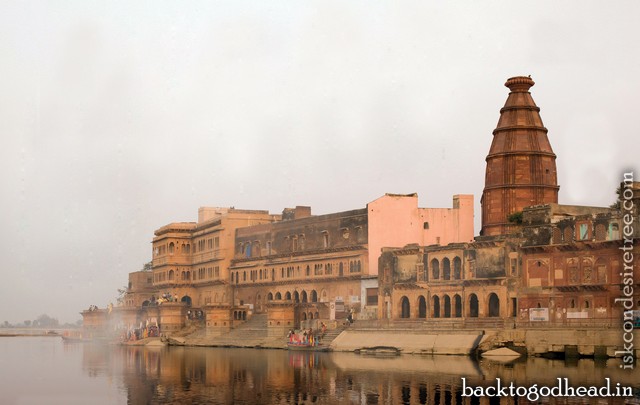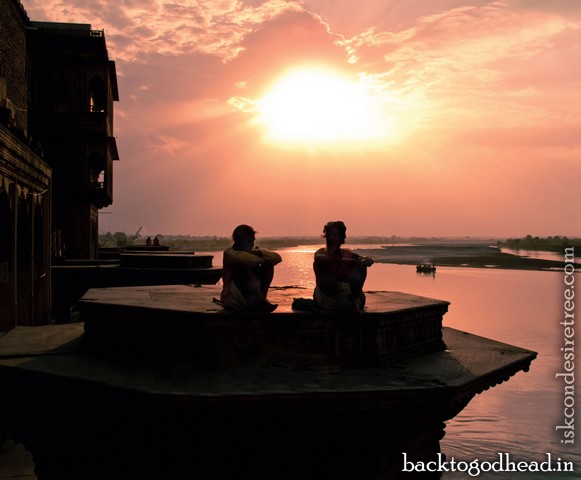
India is Known as punya bhumi, “the land of spiritual merit,” because of its many holy places. among them, Vrindavan, the land of Krishna in the mathura district of uttar Pradesh, is the holiest.
When God descends, so does His eternal abode. Lord Krishna descends with Vrindavan, just as Lord Rama descends with ayodhya. These divine abodes are known as dhamas.
Vrindavan is the sacred playground of Krishna, where He performed His childhood pastimes some five thousand years ago, and His presence is felt here more than anywhere else. When Sri Caitanya mahaprabhu visited Vrindavan in Ce 1523, He disclosed many of the sites of Lord Krishna’s pastimes.
The glories of Vrindavan dhama are described in the Vedic scriptures. For advancement in spiritual life, living or spending time in the dhama is beneficial because one accumulates spiritual merit there. Vrindavan (vrindavana) translates as “the forest of Vrinda,” a cowherd-girl associate of Radha-Krishna who assumes the form of the sacred Tulasi plant (also known as “holy basil”). The greater Vrindavan area is known as Vraja.
In 2009, I found myself in Vrindavan for one month with over a hundred foreigners, none of whom had heard of Vrindavan or even knew who Lord Krishna was.
What would be their impressions of India’s holiest placen
Yoga in the Dhama
I had been interested in yoga for a few years, so when I heard of a one-month yoga course being held in Vrindavan, I took up the opportunity.
Since it was being held in Vrindavan dhama, I expected it would be attended mostly by Krishna devotees. I was surprised that the attendees I met, mostly from the UK, the USA, Germany, France, japan, and argentina, had never heard of Vrindavan and hence were totally oblivious of its significance. They had just ended up in the most auspicious place by chance (or, in fact, by Krishna’s mercy) while looking for a yoga course. I wondered what pious activities they must have done in previous lives to be brought to Vrindavan without their explicit intention or knowledge.
We studied and practiced yoga and pranayama on a rooftop garden, at tree level, near Chira Ghat on the bank of the sacred river yamuna. Green parrots new overhead, and melodious chanting of the Hare Krishna maha-mantra bellowed from the speaker of a local temple. With a guard to protect us from mischievous monkeys, everything seemed perfect and tranquil in the Lord’s land.
Having been born an “ISKCON child” (my parents were initiated by Srila Prabhupada in 1971, when I was in my mother’s womb), I felt responsible for the experiences and impressions these people would get during their first visit to Vrindavan. I wanted everyone to enjoy their time in Vrindavan and learn about Lord Krishna as the Supreme Personality of Godhead. I thought this to be an excellent opportunity to tell people about Krishna. after all, what better topic is there, especially in Krishna’s land?
Many of the people had never sat on the noor to eat before, had never eaten with their fingers or even had a pure vegetarian meal before. For many it was their first trip to India. Despite this, the effect that Vrindavan had on many of the yoga students was encouraging and exceeded my expectations.
Experiencing Vrindavan
We had one day a week off from classes. I would take some of the students on Vrindavan parikrama (circumambulation) and visit ISKCON’s Sri Sri Krishna-Balarama Temple enroute.
I was conscious of what they thought when we bowed down to place our foreheads in the dust of the holy land (pigs had just been roaming around in the same area), and how they would react to their first experience at an ISKCON temple. They had never heard such chanting before or even seen deities.
During the parikramas, I spoke to them about Srila Prabhupada’s teachings and his mercy upon us for introducing Vrindavan to the world. They asked philosophical questions, and we had interesting discussions, including comparisons between Krishna consciousness and other major world religions. They were surprised to see how comfortable they felt with the philosophy and how it made logical sense to them. For example, they appreciated the simple point that since the cow is like a mother and we drink her milk, we do not eat or harm her. The law of karma also seemed commonsense to them.
The most wonderful thing was how very soon they loved Vrindavan. They mentioned how they felt more at home here than anywhere else, how everyone seemed to fit in and feel welcome. I thought this was an interesting observation, because we learn from the teachings of Lord Caitanya that Vrindavan is identical to Krishna’s eternal spiritual abode Krishnaloka, and is therefore everyone’s real eternal home. Seeing and hearing these comments were firsthand proof for me.
Soon, rather than monotonous “hellos,” they were greeting each other with “Radhe! Radhe!” the traditional local greeting, meaning “O Radha! O Radha!”
Transformative Impressions

The energy felt in the ISKCON Vrindavan temple left the most memorable impression on them. Two young women, one american and one english (elizabeth and una), said they had never felt so much joy and energy as when visiting this temple, and felt so blessed. never having seen deities of the Lord before, they joyfully sang the maha-mantra Hare Krishna, Hare Krishna, Krishna Krishna, Hare Hare/ Hare Rama, Hare Rama, Rama Rama, Hare Hare and danced. They never expected such a place existed on this planet, a place where people dance and sing the Lord’s names together indiscriminately, with so much pleasure and inspiration. never having set foot in an ISKCON temple, they danced in ecstasy as if they had been reborn. Their joy and endless ear-to-ear smiling were evident for days after, as they would tell the others how they’d had one of the most wonderful experiences of their life.
Some commented on how caring the Vrajavasis (residents of Vrindavan) are even to animals. They witnessed stray dogs and injured cows being cared for selnessly.
Marie, an older French woman with grown-up children, had never left France before. She was in tears after visiting Seva Kunj and nidhivan, two sites of Krishna’s intimate pastimes that are protected by high walls. She spoke of the remarkable peace and joy she felt there and wished she had visited before, when she was younger.
Alida, a young woman from the former Soviet union, was brought up as a princess with her own servant. She exclaimed she would rather live as a homeless person in Vrindavan than live in a palace elsewhere. upon entering Srila Prabhupada’s Samadhi, she closed her eyes in astonishment when she recognised Srila Prabhupada from a book she had seen some twenty-two years ago as a child. It was the only book on the family bookshelf she would keep reaching for and her muslim parents would keep taking it away from her and putting it back on the shelf. I could see how her fate had finally brought her to Vrindavan. She said she had never before felt the freedom and happiness she felt when dancing in front of the deities.
Darren, an englishman, tried to miss some yoga classes (even though a register was taken) to experience Gaura arati (the daily evening arati ceremony) at the Krishna-Balarama Temple. miu, a well-travelled woman from japan, stayed on for months afterwards. She prefers Vrindavan to her other world travels and does not want to leave.
Upon visiting the Krishna-Balarama Temple, most bought japa malas (beads for chanting) from the temple shop, not only for themselves but for their partners and parents back home. They said that the experience of chanting was so joyful that they would like to take it home and share it with their families.
I felt very happy to have been able to share the sweetness and pleasures of Vrindavan with these yoga students. The sweetness was given to me by my parents and to them by Srila Prabhupada, who kindly came to the Western world to share Krishna consciousness, for which I am eternally grateful.
Meera Khurana lives in London. She holds a Ph.D. in computer science.
